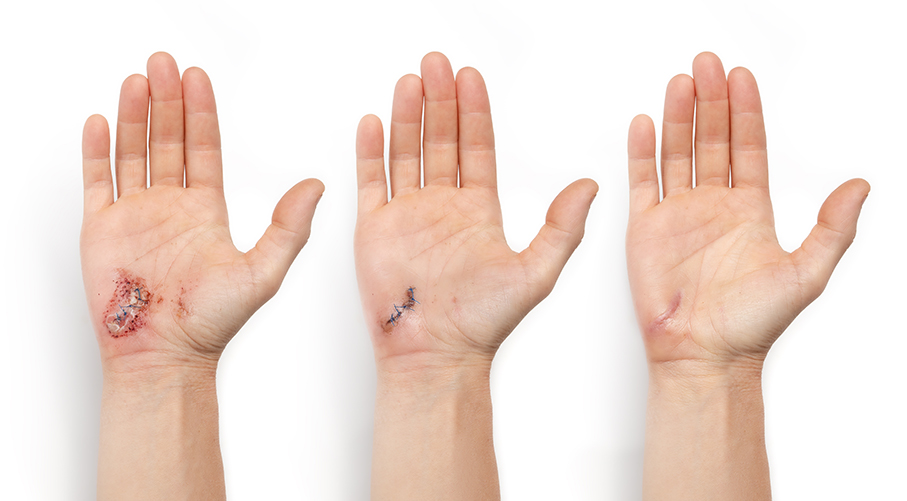Although seemly superficial, a puncture or stab to the hand may damage underlying blood vessels, nerves, muscles, and tendons. These are each invaluable to our everyday hand function. In many cases, immediate treatment is necessary to maintain strong and pain-free hand performance.

Overview
Our hands perform countless actions throughout the day. From simple daily activities such as making a cup of tea to masterful tasks of work and play, the elaborate anatomy of our hands allows us to achieve better overall quality of life.
Possibly appearing inconsequential, a stab, puncture, or deep laceration can cause underlying damage to essential hand structures. For example, damage to nerves may result in loss of sensation, weakness, and pain. Injury to muscles, tendons, and ligaments may furthermore reduce hand strength and function.
Immediate appropriate treatment, like that provided by the dedicated team at CHARMS, ensures hand structures are repaired correctly. A delay, late diagnosis, or postponed treatment may result in structural damage. Unfortunately, this may lead to more complicated surgical options as well as the potential for pain and loss of hand function.
What happens if you stab your hand?
Anatomy Description
The intricate nerves, flexible tendons, and powerful muscles may have acute or long-term damage from a stabbing injury.
Blood Vessels
Blood vessels, the arteries and veins of the hand, are channel-like tubes that carry nourishing blood from the heart all the way to our fingertips. This enables movement and actions of our hands. A stabbing injury can cut blood vessels, disrupting the necessary blood supply to the intricate hand structures. Just 2.3 mm in diameter, the blood vessels of the hand may require specialized surgical intervention to re-establish proper circulation.
Nerves
Our peripheral nerves, the nerves at the ends of our limbs, communicate with the brain and spinal cord. They tell us how and when to move as well as giving us our important sense of touch. Fragile and vulnerable to injury, two types of nerves in our hands are motor nerves and sensory nerves. Motor nerves help control our muscles and sensory nerves convey information about touch, pain, and temperature. Damaged motor nerves may cause muscle weakness, pain, and twitching. When sensory nerves are injured, we may experience loss of sensation, numbness, tingling, and pain.
Muscles
The dexterity and strength in our hands is due to the 34 powerful hand muscles. The combination of power and precision allow us to pick up large objects while also being able to manoeuvre fine instruments. Without our nimble hand muscles, our lives would be very different. Buttoning a shirt, opening a jar, holding hands, and a multitude of daily activities, our hand muscles make our daily lives better. After a stabbing injury to the hand, assessment from the Hand Surgeons at CHARMS will ensure proper healing of the muscles to preserve our important power and precision hand functions.
Tendons
Our tendons are rope-like fibrous cords made of collagen. The cells and blood vessels of tendons help keep them healthy. Most tendons in the hand attach to muscles in the forearm. They slide in protective sheaths to and through the wrist, enabling the bending and straightening of our wrists, fingers, and thumbs. By attaching to bones in our fingers and wrists, our hands become capable of dexterous, powerful, and intricate undertakings. Loss of function after a hand stabbing injury may indicate a cut tendon. Tendons cannot heal themselves. Often, surgical repair and post-surgical care are required to treat the tendon and any surrounding structures that may also be damaged.
Ligaments
Ligaments are like thick rubber bands that provide stability to each of our intricately articulating joints of the hand. They help our joints move smoothly, keep them in proper alignment, and keep them from bending too far. A hand stabbing injury could result in a full-thickness tear of a protective ligament. Surgical intervention and hand therapy may be needed to restore loss of blood supply, ensure joint instability, and reduce potential of chronic pain.
Overview of Symptoms
From seemingly small, superficial wounds to deep lacerations, a stabbing puncture should be assessed by a Hand Specialist. Here’s why.
The severity of a hand injury is difficult to discern by an untrained eye. The intricate and complex anatomy of our hands provide us with countless skills. A stabbing injury, even if very small and barely visible can damage the deep underlying structures of our hands that we rely on daily.
Re-establishing blood supply, restoring nerves, and repairing tendons as soon as possible creates better outcomes. Contacting the Hand Care Team at CHARMS right away will increase the potential of retained hand function after a stabbing injury to the hand.

Symptoms – Some Examples of Hand Stabbing Injuries and The Potential for Long-Term Damage
A puncture wound through the palm may be misleading because the cut may seem clean and simple. The stabbing instrument may not only bring risk of infection or the introduction of a foreign body, but it may also penetrate bone, blood vessels, or cut the flexor tendons or surrounding nerve fibres. Consultation with a hand specialist or hand surgeon is indicated to ensure underlying structures are unaffected or repaired appropriately.
Similarly, a deep cut or stab wound to a finger could damage nerves and tendons along with blood vessels. Left to heal on their own, tendons and ligaments, which allow for dexterous stable movement of the fingers, could be damaged. Without proper investigation and repair, this could lead to losing the ability to fully bend and straighten the injured finger.
Initial Care for an Accidental Hand Stabbing Wound
Here are initial steps for an accidental hand stabbing injury.
- Apply pressure to the wound to stop bleeding.
- Remove any jewellery such as rings, bracelets, or watches which may compromise circulation.
- With warm water and soap, thoroughly clean the area.
- To reduce swelling, apply ice and elevate the hand.

When to Seek Immediate Medical Treatment
With a puncture or stab wound to the hand it can be hard to tell if you need to seek medical treatment. If you experience one or more of these situations, it is the right time to seek immediate medical attention.
- Bleeding persists after a few minutes of direct pressure.
- The cut is deep and dirty.
- The stabbing instrument is a metal object.
- Injury is near or over a joint.
- The stab wound is from an animal or human bite.
- Loss of sensation or range of motion.
How to Prevent Accidentally Stabbing Your Hand
We often take for granted the incredibly useful skills our hands develop. From simple tasks to operating complicated machines, our hands are vulnerable to injury. It is interesting to note that the hand is the most injured part of the body. With their intricate and complex anatomy, healing of the hands can also be difficult. Developing safety measures and identifying hazards are ways to help prevent hand injuries.
Using safe handling techniques is one helpful prevention tip. Washing your hands and keeping them from being slippery may also be useful. Wearing proper gloves can help protect hands. For those using sharp instruments such as knife blades, metal mesh gloves are a great choice to prevent a stabbing injury. Another prevention strategy is to use the correct tool the correct way, as well as keeping a clean work area to help minimise accidents.
Know What to Do to Prevent Permanent Impairment from a Hand-Stabbing Incident
When prevention measures are not enough and you have endured a hand-stabbing incident, it is important to know what to do. Above, we talked about when to seek medical attention. Further, it may be necessary to seek the expertise of a Hand Specialist Surgeon. They will provide thorough examination, determining the history of the injury, circulation, nerve evaluation, sensory and motor analysis, range of motion, as well as flexion and extension.
Our tendons, muscles, and bones work together giving our hands their full range of movement. Tendons attach muscle to bone. A deep cut on the finger, palm, or forearm can damage the tendons and surrounding nerve fibres. An injury such as this requires immediate treatment from a Hand Specialist Surgeon to prevent permanent damage. While a partially cut or torn tendon can be treated non-surgically, a full tear will require stitching the tendon back together. Surgical repair is also necessary for damaged nerves and other structures such as blood vessels.

Surgical Treatment Options
Surgical treatment options will depend on the severity of the stabbing injury. A simple surgery may consist of opening the deep cut to allow the surgeon to carefully clean the wound, remove any debris or foreign body, and meticulously stitch the wound closed. If there is further damage though, the surgical treatment may include repairing nerves, tendons, blood vessels, and other underlying structures. When diagnosis and treatment has been delayed, it may be necessary for the Hand Specialist Surgeon to carry out more complicated surgical procedures such as grafting the tendon.
Rehabilitation Treatment Options
Based upon the Hand Care Teams’ assessment, non-surgical treatment options may be available to repair a hand stabbing injury. Physical therapy and customised splinting options may be prescribed. Even if surgery is undertaken, the Hand Care Team at CHARMS will provide the optimal post-surgical rehabilitation and therapeutic care.
How CHARMS Can Help
The team at the Centre for Hand and Reconstructive Microsurgery Singapore (CHARMS) includes senior, nationally and internationally renowned hand surgeons and hand therapists. This dedicated team provides personalised treatment at the highest level. If you have endured a hand puncture or hand stabbing incident, their more than 50 year’s combined experience will aim to give you the best possible outcome to maintain strong and pain-free hand performance.